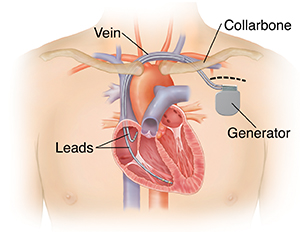Implantable Cardioverter Defibrillator (ICD)
Implantable Cardioverter Defibrillator (ICD)
An ICD is a device that is placed permanently inside your body. It monitors your heart rhythm (the speed and pattern of your heartbeat). If this rhythm becomes too fast and potentially dangerous, the ICD sends out electrical signals, either rapid pacing or an electric shock, that help bring the rhythm back to normal. The ICD is put inside your body during a minor surgical procedure called implantation. In most cases, implantation takes about an hour.
How do I get ready for this procedure?
Don’t eat or drink anything after midnight the night before the procedure, or 8 hours before the procedure.
Follow your healthcare provider's instructions on what medicines to take.
You may be asked to shower with antibacterial soap the night before your procedure and the morning of the procedure. Ask your provider if he or she wants you to use a certain kind of soap.
Your provider may ask you to use clean bed sheets and pajamas the night before the procedure.
What happens during the procedure?
The ICD is usually put on the left side of your chest. Putting the ICD in your body (implantation) does not need open heart surgery. This means your chest will not be opened. During the procedure:
You will be given medicine to help you relax.
The doctor makes a cut (incision) in the skin below your collarbone. This creates a “pocket” to hold the ICD.
The doctor threads a wire (lead) through the incision into a vein in the upper chest. With the help of X-ray monitors, the doctor guides the lead into one of the heart’s chambers. Depending on how many leads your ICD has, this process may be repeated to guide leads into other chambers.
The doctor attaches the leads to the heart muscle so they will stay in place. The leads will be tested to make sure they are placed correctly.
The battery (generator) is attached to the leads. Then the doctor places the generator in its pocket under the skin.
The doctor may start (induce) a fast heart rhythm to test the ICD.
Antibiotic solution is used to clean the pocket.
When everything else is done, the incision is closed with sutures that dissolve, medical glue, or staples.
Other implantation sites
In some cases, the ICD can be put elsewhere in the body. This could be on the right side of the chest, or on the left side under the muscle. If one of these is an option for you, your doctor will explain more.
What happens after the procedure?
You will stay in the hospital overnight. While you are in the hospital, your heart’s signals are monitored to see how the ICD is working. You can go home when your condition is stable. Once you get home:
Follow your discharge instructions to care for your incision. Watch for signs of infection (see box).
Follow any special instructions to care for the side of your body where your ICD was implanted. Your doctor may tell you not to raise that arm above the shoulder for a certain amount of time.
You’ll likely have bruising at the incision site. This is normal and will go away as the incision heals.
You can probably return to your normal routine soon after implantation. Ask your doctor when you can return to work.
You may be instructed not to drive for a certain amount of time. Generally, you should not drive for about 6 months after having an ICD implanted, or if the device delivers a shock. Commercial driving with an ICD is not allowed by most state laws because of the risk of losing consciousness from life threatening heart rhythms that this device is designed to treat.
See your doctor for follow-up visits as recommended.
Call 911
Call 911 if you have:
Chest pain
Severe shortness of breath
When to call your healthcare provider
Call your healthcare team if you have any of the following:
Signs of an infection, such as: fever over 100.4ºF (38ºC), drainage from the incision, or redness, swelling, or warmth at the incision site
Twitching chest muscles
Pain around your ICD that gets worse, not better
Bleeding from your incision
Swelling in the arm on the side of the incision site
Severe swelling of the incision site (bulging up like a golf ball)
You receive a shock from your ICD
Your device generator feels loose under the skin or wiggles in the pocket
Updated:
August 07, 2018
Sources:
Dellinger, Surviving Sepsis Campaign,, International Guidelines for Management of Severe Sepsis and Septic Shock, Critical Care Medicine (2013); 41(2);580-637, Driving Restrictions in patient swith an implantable cardioverter-defibrillator, Up To Date, ICD Implantation. UpToDate., Implantable Cardioverter-Defibrillators: Complications, UpToDate
Reviewed By:
Image reviewed by StayWell medical illustration team.,Kang, Steven, MD,Snyder, Mandy, APRN
